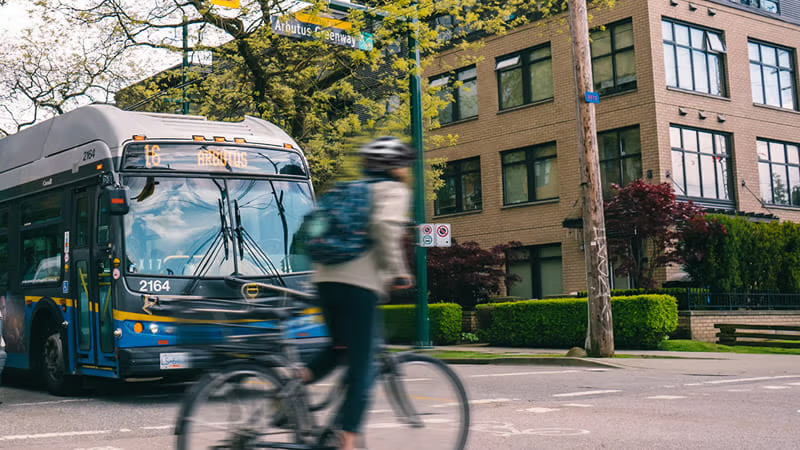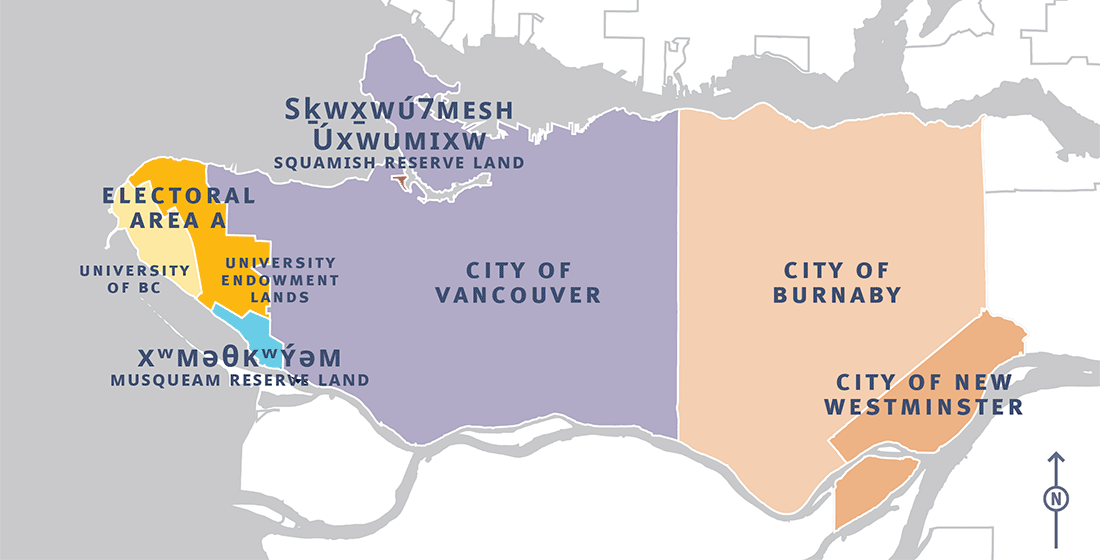Burrard Peninsula Area Transport Plan

The Burrard Peninsula Area Transport Plan (BP ATP) will identify and prioritize recommended actions related to bus service, cycling, walking, and goods movement for the transportation network within the Burrard Peninsula. This area encompasses Burnaby, New Westminster, Vancouver, and the University of British Columbia (UBC) and the surrounding University Endowment Lands (UEL), which are part of Electoral Area A.
The study area also includes the traditional and unceded territories of several Indigenous Nations including kʷikʷəƛ̓əm (Kwikwetlem First Nation), q̓ʷɑ:n̓ƛ̓ən̓ (Kwantlen First Nation), xʷməθkʷəy̓əm (Musqueam), Sḵwx̱wú7mesh Úxwumixw (Squamish Nation), səlilwətaɬ (Tsleil-Waututh Nation), and qiqéyt (Qayqayt First Nation).
Guided by our regional transportation strategy, Transport 2050, and its vision of ‘Access for Everyone’, the BP ATP will help TransLink prioritize future investments in the transportation network, so that everyone can easily connect to people, places, and opportunities.
Study Area

Phase 2 Discussion Guide and Engagement Summary
As part of Phase 2 of the BP ATP planning process, from Feb. 17 to March 9, 2025, we asked for input on the draft bus network changes and priority areas for active transportation improvements. Public input was crucial in helping us understand how to best implement these draft actions to improve transportation in the region. See the links below for the Discussion Guide that was prepared for this public engagement period to provide further details on how the draft bus network changes relate to one another, as well as draft actions for walking, cycling, and goods movement.
The public feedback that was gathered is summarized in the Public Engagement Summary Report (and appendices) below. This feedback, along with additional input from our local, regional, and provincial partners, is helping to refine the actions and network changes for the final Burrard Peninsula Area Transport Plan.
Phase 1 Summary
The first phase of the Burrard Peninsula Area Transport Plan planning process was completed in 2024. During this phase of work, we looked at how people use the transportation network and how that usage might change in the future as the Burrard Peninsula continues to grow.
The key findings from this work have been summarized in the Phase 1 Summary Report, which provides an overview of the current transportation context and identifies areas where improvements could be made.
Using an online survey and multiple in-person events, we also asked people who travel within the study area what’s working and what could be improved to make transit and active transportation more convenient.
Read the Phase 1 Public Engagement Summary Report (and Appendices A-G), for a more detailed look at what we did during Phase 1 Public Engagement.
Timeline
2023
-
Phase 1: Issues & Opportunities
-
Stakeholder Engagement: Throughout, with public input in Q3
-
First Nations Engagement: Throughout
2024
-
Phase 2: Priority Actions
-
Stakeholder Engagement: Throughout
-
First Nations Engagement: Throughout
2025
-
Phase 2: Develop Final Plan
-
Stakeholder Engagement: Throughout, with public input in Q1
-
First Nations Engagement: Throughout
FAQs
What is an Area Transport Plan?
Area Transport Plans are an opportunity for TransLink to work more closely with local governments, Indigenous Nations, stakeholders, and the public to develop plans for enhancing bus service and infrastructure within specific areas of Metro Vancouver, while also addressing aspects of cycling, walking, and goods movement.
Area Transport Plans are informed by and help to advance the goals and objectives outlined in Transport 2050 and Access for Everyone. Together, these plans establish the region’s long-term transportation vision, overall goals, targets, policy direction, and investment priorities.
To view current and past plans, visit our Area Transport Planning page.
Why is this plan focused on the Burrard Peninsula?
To make sure we understand the local area and its needs when planning the regional transportation network, TransLink divides Metro Vancouver into smaller parts called sub-regions. These sub-region boundaries have changed over time as the region grows and develops.
The Burrard Peninsula has seen a lot of growth since the last Area Transport Plans were completed (Burnaby/New Westminster in 2003, Vancouver/UBC in 2005). Today, many of the routes that serve the Burrard Peninsula study area travel across municipal boundaries. To better understand the changing transportation needs of this sub-region, we decided to combine the sub-regions of Burnaby and New Westminster with Vancouver and UBC. Together these municipalities and traditional and unceded territories of Indigenous Nations – including Musqueam, Squamish Nation, Tsleil-Waututh Nation, Kwikwetlem First Nation, Kwantlen First Nation, and Qayqayt First Nation – form the BP ATP study area.
What is the planning process?
-
Phase 1: Issues and Opportunities (2023): During this phase, we asked people about how they travel in the area and studied how the area and transportation network might change in the future. We also looked at how people were using the network to see what was working and what wasn’t. This helped us understand where we can make improvements.
-
Phase 2: Priority Actions (2024/25): During the first part of this phase, we developed a range of draft actions that would improve how people move throughout the Burrard Peninsula. These actions relate to the bus network, cycling, and walking, as well as goods movement. Now, we’re asking for public feedback on these actions and how to prioritize them.
-
Based on the feedback received, as well as additional technical analysis and input from local partners, we’ll revise the draft actions and develop the final Burrard Peninsula Area Transport Plan. The plan is anticipated to be adopted in early 2026.
How is this plan different than transportation plans and priorities at the municipal level?
Area Transport Plans focus on a specific part of the region, whereas municipal transportation plans and strategies tend to focus on a single municipality, or neighbourhoods/areas within a municipality. We work with municipalities throughout the ATP planning process to ensure the ATPs support the transportation plans and priorities of each local area. This helps us make sure that transportation planning and investments align with what each community wants and needs. In addition, TransLink works with municipalities to ensure municipal transportation plans are aligned with bigger regional plans such as Transport 2050 and Access for Everyone
Who implements the outcomes of the BP ATP?
It depends on the nature of each recommended action. TransLink is responsible for some of the important actions and priorities mentioned in the plan, such as developing a new bus route or increasing frequency on a busy route to meet growing demand.
For other recommended actions, like building new or upgrading existing walking and cycling routes, it’s the job of the local municipality or other agencies, like the Ministry of Transportation and Transit, to make those things a reality. TransLink supports these projects through our Local Government Funding Programs which allocates funding to municipalities for active travel projects including bus priority, walking, and cycling infrastructure.
Contact Us
You can contact us directly through the BP ATP project email at areatransportplanning@translink.ca to share any feedback, suggestions, or questions you may have regarding the BP ATP and/or the planning process.
TransLink Listens
Join the panel and help us improve transportation for the region. Registration is quick and easy.
eNewsletter Subscription
Want to stay up-to-date on Area Transport Plans and other plans and projects? Sign up for TransLink eNewsletters.

